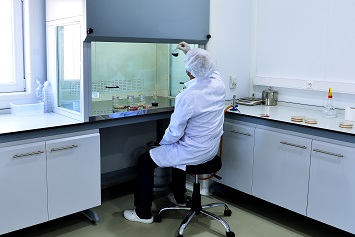THANKS TO JKP SIR AND ASSOCIATES TO HELP TO RENOVATE OLD FUME HOOD.
Who Needs Fume Hoods?
Fume Hoods Protect Workers Against Chemical Hazards
Laboratories are a unique environment when it comes to chemical hazards. Laboratory workers use a broad variety of chemicals, in relatively small quantities, and in combinations and bench-scale procedures that may be unlike anything found in a larger-scale operation. But that doesn’t mean that their chemical exposures are insignificant. In fact, lab workers may be exposed to potentially deadly quantities of volatile toxic chemicals. For inhalation exposures, their engineered protection of choice is the chemical fume hood.
Chemical fume hoods can be somewhat fussy, requiring skilled use and regular adjustments and maintenance in order to provide the protection workers need.
Who Needs Fume Hoods? ![]()
A chemical fume hood is a specialized type of local exhaust ventilation that enables laboratory workers to conduct bench-scale reactions in an enclosed, ventilated space. Fume hoods are usually connected to the building’s exhaust system and do not recirculate air. Ductless fume hoods, which filter and recirculate air, are available for some limited applications. Chemical fume hoods should not be confused with laminar flow cabinets, which can look similar but are designed to protect samples inside the hood from contamination by pulling clean air into the hood and exhausting it into the laboratory.
According to Appendix A of the Occupational Safety and Health Administration’s (OSHA) Laboratory Standard (29 CFR 1910.1450), chemical fume hoods should be used for operations that might result in the release of toxic chemical vapors or dust. The question of “how toxic does it have to be?” has no definitive answer, but in general, OSHA recommends the use of a chemical fume hood or some other type of local ventilation for workers who are using volatile chemicals with a threshold limit value (TLV) of less than 50 parts per million (ppm). Some fume hoods are also designed for use with radioisotopes.
How to Use a Fume Hood
Workers who use fume hoods should have a basic understanding of how they work.
- The hood draws air in through the face, across the surface, to the back of the hood. In order to avoid disrupting the airflow at the face of the hood, workers close nearby windows and doors and should not use fans near fume hoods.
- The airflow can be turned on and off; it should always be on when the hood is in use. The hood may be left on when it is not in use, if hazardous chemicals are temporarily left inside, or if there is a possibility that general laboratory ventilation will be inadequate. Otherwise, the hood can be turned off when it is empty and not in use.
- The operating level for the sash will be marked on the frame of the hood; when employees are manipulating objects and chemicals inside the hood, the sash should be set at that mark. When no one is working with materials inside the hood, the sash should be kept closed.
- Employees should never place their heads inside the hood opening. For vertical rising sashes, the operating level of the sash will generally be below the level of a worker’s face. For horizontal sliding sashes, workers should position the sash in front of their face, and work around the side of it. For additional protection, workers should wear protective eyewear.
- There is a gauge that indicates airflow; employees should check to make sure that this is in the required range while they are working. Malfunctioning hoods should be tagged out of service until they are repaired.
- Some processes conducted in a hood may be left unattended, if proper procedures are followed, but materials should not be stored in the hood.
- Materials inside the hood should not block vents or airflow. Large equipment should be placed on stands at least 2 inches (in.) off the base of the hood’s interior so that airflow will be maintained, and all materials inside the hood should be placed at least 6 in. from the opening.
- Workers should know what to do in the event of an emergency or power failure.
For work with chemical carcinogens or hazardous biological agents, workers will need to step up to the next level of protection: the biological safety cabinet.
